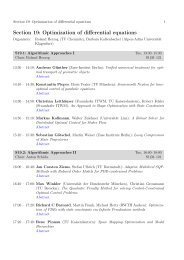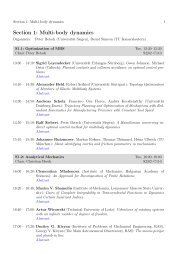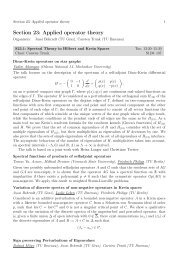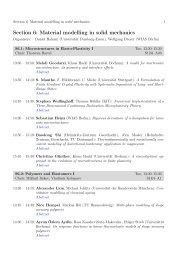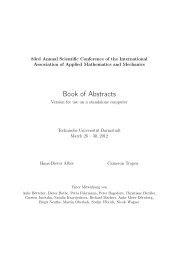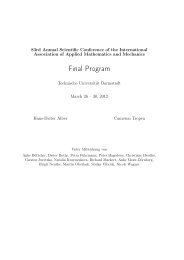Section 6: Material modelling in solid mechanics - GAMM 2012
Section 6: Material modelling in solid mechanics - GAMM 2012
Section 6: Material modelling in solid mechanics - GAMM 2012
Create successful ePaper yourself
Turn your PDF publications into a flip-book with our unique Google optimized e-Paper software.
12 <strong>Section</strong> 6: <strong>Material</strong> <strong>modell<strong>in</strong>g</strong> <strong>in</strong> <strong>solid</strong> <strong>mechanics</strong><br />
1992<br />
Deformation <strong>in</strong>duced martensite transformation <strong>in</strong> a cold-worked form<strong>in</strong>g process of<br />
austenitic sta<strong>in</strong>less steel<br />
Tim Dally, Kerst<strong>in</strong> We<strong>in</strong>berg (Universität Siegen)<br />
With<strong>in</strong> the last years the goal of <strong>in</strong>dustrial manufactur<strong>in</strong>g processes - such as tube form<strong>in</strong>g - has<br />
shifted towards an optimization of technological as well as mechanical properties of the manufactured<br />
structures. For example, dur<strong>in</strong>g the form<strong>in</strong>g procedure of sheets made of austenitic sta<strong>in</strong>less<br />
steel X5CrNi18-10, the content of stra<strong>in</strong>-<strong>in</strong>duced martensite needs to be controlled. In order to<br />
achieve optimal structural properties of the manufactured tube with respect to very high-cycle<br />
fatigue (VHCF), a martensite ratio of approximately 25% needs to be obta<strong>in</strong>ed.<br />
On the basis of experimental <strong>in</strong>vestigations our contribution deals with the numerical simulation<br />
of the form<strong>in</strong>g process with special consideration of the martensite ratio c as a function of<br />
temperature and deformation field:<br />
c = c(T, ε p ).<br />
In particular, we study the <strong>in</strong>teraction of process<strong>in</strong>g temperature, friction, plastic deformation<br />
and stress state dur<strong>in</strong>g form<strong>in</strong>g. We will further present different approaches of <strong>modell<strong>in</strong>g</strong> the<br />
martensite evolution as well as the extension of an exist<strong>in</strong>g martensite model on polyaxial states<br />
of stress and compare experimental results and numerical simulations for the modified model.<br />
Additionally a facility to calculate the harden<strong>in</strong>g due to martensitic phase transformation will be<br />
presented.<br />
F<strong>in</strong>ally, we will propose a strategy to control the martensite evolution dur<strong>in</strong>g the tube-form<strong>in</strong>g<br />
process that enables us to achieve the optimal c mentioned above.<br />
Micromechanical model<strong>in</strong>g of ba<strong>in</strong>itic phase transformation<br />
A. Schneidt, R. Mahnken (Universität Paderborn), T. Antretter (Montanuniversität Leoben)<br />
We develop a micromechanical material model for phase transformation from austenite to ba<strong>in</strong>ite<br />
for a polycrystall<strong>in</strong>e low alloys steel. In this material (e.g. 51CrV4) the phase changes from<br />
austenite to perlite-ferrite, ba<strong>in</strong>ite or martensite, respectively. This work is concerned with phase<br />
transformation between austenite and n-ba<strong>in</strong>ite variants <strong>in</strong> different orientated gra<strong>in</strong>s. Characteristic<br />
of ba<strong>in</strong>ite are the comb<strong>in</strong>ation of time-dependent transformation k<strong>in</strong>etics and lattice shear<strong>in</strong>g<br />
<strong>in</strong> the microstructure. These effects are considered on the microscale and by means of homogenisation<br />
scale <strong>in</strong> the polycrystall<strong>in</strong>e macroscale with stochastically orientated gra<strong>in</strong>s. Furthermore, the<br />
numerical implementation of our model with a Newton projection algorithm <strong>in</strong>to a f<strong>in</strong>ite-element<br />
program is presented, based on the algorithm <strong>in</strong> [1].<br />
[1] R. Mahnken and S. Wilmanns, A projected Newton algorithm for simulation of multivariant<br />
textured polycrystall<strong>in</strong>e shape memory alloys. Computational <strong>Material</strong>s Science 50,<br />
25352548, 2011.<br />
Effects of heat treatment on phase transformation <strong>in</strong> powder metallurgical multifunctional<br />
coat<strong>in</strong>g<br />
Reza Kebriaei, Jan Frischkorn, Stefanie Reese (RWTH Aachen)



